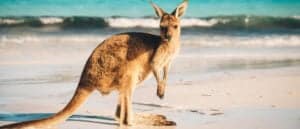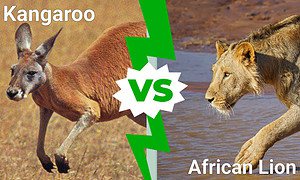Marsupials are a class of mammals known for their stomach pouches. In fact, the name “marsupial” is from the Latinized Greek word “marsupium,” which is the technical term for the abdominal pouch of this group of mammals. Kangaroos are arguably the most popular members of this group. In fact, they’re so popular they have an entire island named after them. However, they’re not the only marsupials. There are others like the koala, Tasmanian devil, and opossum. One thing that is common to all marsupials is their skin pouch. Ever wondered what’s inside a kangaroo pouch or what the inside of the pouch looks like? Read on to discover some interesting facts about the kangaroo’s pouch and what’s inside it.
What Is Inside a Kangaroo’s Pouch?

The kangaroo pouch is a haven for joeys to stay in to feed and grow.
©IntoTheWorld/Shutterstock.com
The kangaroo pouch is a pocket of skin that helps the female kangaroo to take care of her young. Typically, a mature female kangaroo will have a young in this pouch for roughly nine months within a year. If the conditions are favorable, she may even have two joeys of different ages whose survival depends on this pouch. It’s a safe, cozy, and stress-free environment for the young kangaroo to grow and feed. The joey (young kangaroo) in the pouch can be anything from a jelly bean size (weighing less than a gram) to a young juvenile over 10 pounds in weight. The pouch stretches to fit the baby as it gets bigger.
The pouch is an important adaptation for reproduction in marsupials. Although the young kangaroo spends most of its early months in the pouch, it is not born in the pouch. Instead, it emerges from an opening close to the base of the mother’s tail known as the cloaca and finds its way into the pouch. The baby kangaroo is born blind and hairless. It crawls into the comfy pouch of its mother, which is warm and has teats from which it can feed. The joey stays comfortable and develops in this pouch for at least six months.
The pouch is necessary for the survival of baby kangaroos because the joey is tiny, premature, and fragile. The young animal will simply not make it on its own outside the pouch. They need warmth and protection, and that is where the pouch comes in handy. The kangaroo pouch is a haven for joeys to stay in to feed and grow. It also protects them from predators since the mother kangaroo can easily run away with her young in her pouch if a predator approaches.
What Is It Like Inside a Kangaroo’s Pouch?
The pouch is more than just a sack for the joey to stay in. It has everything your marsupial needs to survive and grow. The inside of a kangaroo’s pouch is almost the same texture as the kangaroo’s skin. It is soft, hairless, and also very warm. Typically, the temperature in the kangaroo’s pouch is around 105 degrees Fahrenheit, which is perfect for keeping the hairless joey cozy and warm. The fleshy pocket is typically stretchy enough to hold a 13-pound juvenile kangaroo and slightly sticky.
The pouch has four teats (milk ducts) for feeding the premature joey. One of the marvels of the marsupial’s pouch is how it can adapt to the young kangaroo developing in it. Not only does it expand in size as the joey grows, but the nutrient in the milk supplied by the teat also changes depending on the joey’s age. The pouch’s skin secretes antimicrobial substances, which reduces the chances of the baby kangaroo getting infected while in the pouch.
Can the Kangaroo Have More Than One Joey in the Pouch?

Female kangaroos give birth to one joey at a time.
©iStock.com/burroblando
One of the fascinating things about female kangaroos is that they can have up to three growing joeys simultaneously. But they don’t give birth to more than one at a time. The three joeys are typically at different ages, with one growing in the womb, one in the pouch, and the other already venturing outside but also dependent on milk from the pouch to survive.
A young joey must stay in the pouch for at least six months before venturing outside for the first time. After emerging, the baby kangaroo spends most of its time with its mother and can return to the pouch if it wants. The joey is weaned at about 10 to 12 months; at this point, it no longer returns to the pouch.
However, if the conditions are right, a new tenant may take over the pouch between the time the joey starts venturing outside occasionally and when it gets fully weaned. The mom can produce multiple types of milk at the same time, and this allows the two babies of different ages to feed from the pouch at the same time. At this stage, the older joey stays outside the pouch most of the time but can stretch its head into the pouch to feed.
Even more interesting, the kangaroo can get pregnant again while taking care of two young like this. In this case, implantation is delayed until the pouch is vacant again and a new joey can move in.
Do Kangaroos Clean Their Pouches?
Baby kangaroos make a mess while staying in the pouch. The poop and pee remain inside the pouch because the baby kangaroo does not go anywhere else for the first few months. But As they grow older, they’re able to explore outside the pouch. Even at this stage, the young kangaroo will bring dirt into the pouch on its way in.
Since the pouch is fully enclosed and opens upward rather than downward to keep the joey from falling out, the female kangaroo has to clean it herself to get rid of all the poo, pee and dirt from having the joey in there.
Typically, this cleaning takes place before a new joey is born. The pouch needs to be clean if the young kangaroo inside the pouch is to stay healthy. To clean the pouch, the mother kangaroo dips her small head inside the pouch, licking the pouch clean with her tongue.
Conclusion
Kangaroos are popular animals in Australia and many other locations around the world. But perhaps the most notable thing about this animal is its incredible pouch. The comfy home for baby kangaroos is a true marvel of nature and arguably one of the most impressive natural structures of any animal.
Up Next
- Jacked Kangaroo: Just How Strong Are Buff Kangaroos?
- Wallaby vs. Kangaroo: More Than Just Different Types of Kangaroos
- 10 Incredible Tree Kangaroo Facts
The photo featured at the top of this post is © kimonofish/Shutterstock.com
Thank you for reading! Have some feedback for us? Contact the AZ Animals editorial team.






